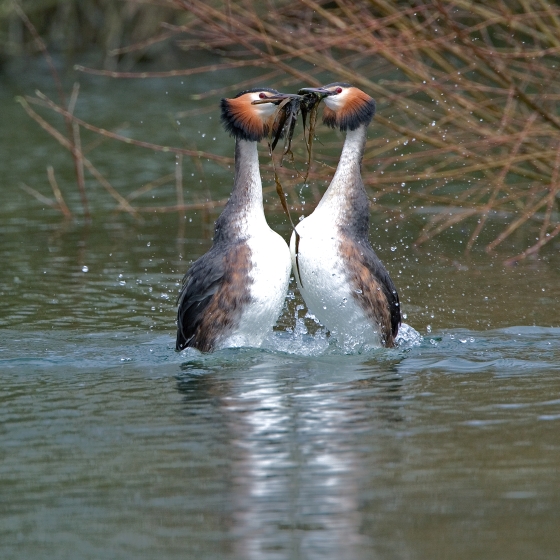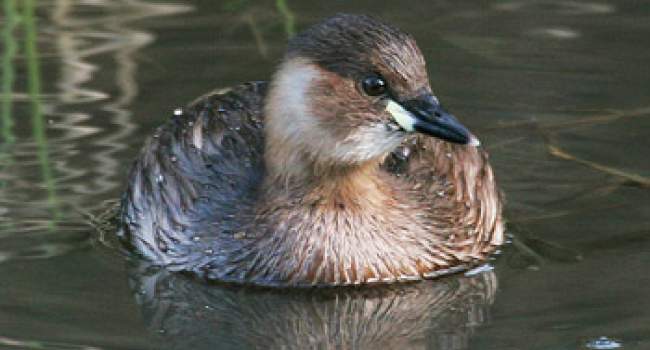Great Crested Grebe
Podiceps cristatus (Linnaeus, 1758)
GG
 GRCGR
GRCGR  90
90

Family: Podicipediformes > Podicipedidae

The Great Crested Grebe is a graceful waterbird with ornate head plumage and a dance-like courtship display.
Uniquely suited for life on the water, the Great Crested Grebe has legs placed far back on its body, which makes it clumsy on land. In summer, birds primarily inhabit reed-bordered lakes, where they eat fish and aquatic invertebrates. They can be found offshore in the winter months, when their drabber plumage and long neck means they can be confused with divers and other grebe species.
Historically persecuted for its beautiful feathers, the Great Crested Grebe population was once reduced to as few as 32 known pairs in England. Numbers increased from the mid-19th century up until 1996, after which little evidence of population change has been detected.
Exploring the trends for Great Crested Grebe
Our Trends Explorer will also give you the latest insight into how the UK's Great Crested Grebe population is changing.
trends explorerIdentification
Great Crested Grebe identification is usually straightforward. The following article may help when identifying Great Crested Grebe.
Identifying winter Grebes

From Great Crested and Red-necked to Slavonian and Black-necked, separating grebes in winter plumage can be challenging. This identification video from the BTO discusses all the features to help identify them with confidence.
SONGS AND CALLS
Listen to example recordings of the main vocalisations of Great Crested Grebe, provided by xeno-canto contributors.
Begging call
Call
Develop your bird ID skills with our training courses
Our interactive online courses are a great way to develop your bird identification skills, whether you're new to the hobby or a competent birder looking to hone your abilities.
Browse training coursesStatus and Trends
Population size and trends and patterns of distribution based on BTO surveys and atlases with data collected by BTO volunteers.
CONSERVATION STATUS
This species can be found on the following statutory and conservation listings and schedules.
POPULATION CHANGE
This species was believed to be on the verge of extinction in Britain around 1860, when only 32-72 pairs were known in England (Holloway 1996). A subsequent increase followed reductions in persecution, aided by statutory protection, and the creation of extensive new habitat in the form of gravel pits (Gibbons et al. 1993). Increase was tracked by special surveys to around 7,000 adult birds in Britain by 1975 (Hughes et al. 1979). The BBS provides the first national-scale annual monitoring of this species and indicates no clear trend since 1995. Winter numbers have shown a long-term shallow increase which peaked in the mid-2000s, followed by a subsequent shallow decline until around 2013 (WeBS: Frost et al. 2020). A decline has occurred across Europe since 1990 (PECBMS: PECBMS 2020a>).
| UK breeding population |
No population change in UK (1995–2022) 
|
| UK winter population |
-19% decrease (1996/97–2021/22)  |
Exploring the trends for Great Crested Grebe
Our Trends Explorer will also give you the latest insight into how the UK's Great Crested Grebe population is changing.
trends explorerDISTRIBUTION
Wintering Great Crested Grebes occur on lowland lakes, estuaries and on shallow sea coasts. They are particularly abundant in central and southern England and central Scotland. The breeding distribution is similar, although restricted to freshwater lakes and rivers.
Occupied 10-km squares in UK
| No. occupied in breeding season | 1062 |
| % occupied in breeding season | 35 |
| No. occupied in winter | 1234 |
| % occupied in winter | 41 |
European Distribution Map
European Breeding Bird Atlas 2
Breeding Season Habitats
| Most frequent in |
Lakes 
|
DISTRIBUTION CHANGE
Breeding and wintering ranges have expanded in recent decades.
Change in occupied 10-km squares in the UK
| % change in range in breeding season (1968–72 to 2008–11) | +28.5% |
| % change in range in winter (1981–84 to 2007–11) | +20.8% |
SEASONALITY
Great Crested Grebes are recorded fairly consistently throughout the year.

Movement
Information about movement and migration based on online bird portals (e.g. BirdTrack), Ringing schemes and tracking studies.
RINGING RECOVERIES
View a summary of recoveries in the Online Ringing Report.
Foreign locations of birds ringed or recovered in Britain & Ireland

Biology
Lifecycle and body size information about Great Crested Grebe, including statistics on nesting, eggs and lifespan based on BTO ringing and nest recording data.
PRODUCTIVITY & NESTING
Number of Broods 
|
1 (2) |
Egg Size 
|
56×37 mm Weight = 39.5 g (of which 9% is shell) |
Exploring the trends for Great Crested Grebe
Our Trends Explorer will also give you the latest insight into how the UK's Great Crested Grebe population is changing.
trends explorerSURVIVAL & LONGEVITY
View number ringed each year in the Online Ringing Report
Maximum Age from Ringing 
|
11 years 10 months 5 days (set in 1978) 
|
Exploring the trends for Great Crested Grebe
Our Trends Explorer will also give you the latest insight into how the UK's Great Crested Grebe population is changing.
trends explorerCODES & CLASSIFICATION
Ring size 
|
G or H* |
Field Codes 
|
2-letter: GG | 5-letter code: GRCGR | Euring: 90 |
For information in another language (where available) click on a linked name
Research
Interpretation and scientific publications about Great Crested Grebe from BTO scientists.
CAUSES AND SOLUTIONS
Causes of change
There is little good evidence available regarding the drivers of the breeding population change in this species in the UK.
Further information on causes of change
No further information available.
Information about conservation actions
The Great Crested Grebe successfully recovered after being subject to persecution in Victorian times, and BBS results indicate that numbers have been stable since at least 1994; hence this is not a species of conservation concern and specific conservation action to benefit this species is not currently required. Great Crested Grebes prefer mesotrophic to eutrophic conditions and hence may currently be benefiting from nutrient inputs from agriculture (provided conditions do not become hypertrophic), although any benefit is likely to be at the expense of other waterbirds and other taxa which are negatively affected by eutrophication (Keller & Korner-Nievergelt 2019). The continuation of local management actions and wider policies to maintain and create good quality wetland habitats for other wildfowl species are likely to continue to benefit this species.
Links to more studies from ConservationEvidence.com
- Changes in the breeding bird population of a small clay river following flood alleviation works
- A strategy for minimizing waterfowl deaths on toxic waterbodies
- Post-release survival of oiled, cleaned seabirds in North America
Read more studies about Great Crested Grebe on Conservation Evidence >
Would you like to search for another species?













Share this page